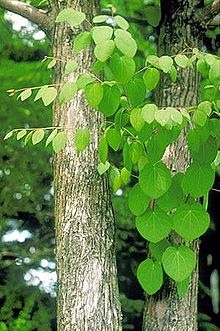- Cercidiphyllum
-
Cercidiphyllum 
Katsura (C. japonicum) trunk and foliage Scientific classification Kingdom: Plantae (unranked): Angiosperms (unranked): Eudicots (unranked): Core eudicots Order: Saxifragales Family: Cercidiphyllaceae Genus: Cercidiphyllum
Siebold & Zucc.Species C. japonicum
C. magnificumCercidiphyllum is a genus containing two species of plants, both commonly called Katsura. They are the sole members of the monotypic family Cercidiphyllaceae. The genus is native to Japan and China.
The type species, Cercidiphyllum japonicum, can reach 45 m in height, and is one of the largest hardwoods in Asia. The other species, Cercidiphyllum magnificum, is much smaller, rarely reaching over 10 m in height. Cercidiphyllum produces spurs along its twigs. These are short stems with closely spaced leaves. The foliage is dimorphic. According to a recent description "short shoots bear broadly cordate or reniform, palmately veined leaves with crenate margins; long shoots bear elliptic to broadly ovate leaves with entire or finely serrate margins." [1] Leaf size varies from 3–8 cm long and 3-5.5 cm broad. The genus is dioecious, having separate male and female trees. The small inconspicuous flowers are produced in early spring and wind-pollinated; the fruit is a cluster of 2-4 small pods, each pod 1–2 cm long with numerous small, flattened and winged seeds. The fruits mature in autumn and release their seeds in autumn through winter.
Katsura is the Japanese name for the tree. The scientific name Cercidiphyllum refers to the close resemblance of the leaves to those of Cercis (redbuds); these two unrelated genera can however be distinguished easily as redbud leaves are alternate, not opposite.
The two species are:
- Cercidiphyllum japonicum. Throughout the range of the genus. Typically a multi-stemmed tree to 40–45 m tall in the wild, though typically smaller in cultivation. Bark rough, furrowed. Leaves smaller, not over 4.5 cm long and 3.2 cm broad; stipules falling soon after leafing out in spring. Seed winged only at lower end. Plants from China were at one time separated as C. japonicum var. sinense, but no consistent difference between Japanese and Chinese origins has been found.
- Cercidiphyllum magnificum. Endemic to central Honshū, where it grows at higher altitudes than C. japonicum. A small tree, not more than 10 m tall. Bark smooth. Leaves larger, up to 8 cm long and 5.5 cm broad; stipules persistent. Seed winged at both ends.
Cultivation
Katsura is grown as an ornamental tree for its delicate heart shaped leaves and bright autumn colour, a mix of bright yellow, pink and orange-red. Where conditions are suitable, it is fast-growing, but it is very sensitive to drought and needs deep, permanently moist soil. Under drought conditions, the species will abscise its leaves; however refoliation may occur once water is made available. Of particular interest is the scent produced by the leaves in the autumn, resembling burnt brown sugar or cotton candy. Trees in cultivation, like those in natural environments, tend to sucker from the base when young and become multi-stemmed at maturity; pruning to maintain a single stem is not advised.
Within Cercidiphyllum japonicum, several cultivars with pendulous branches are grown for their unique weeping habit. Two general types exist. Those with a strong central leader, or excurrent growth, are all one clone originating in Morioka City, Japan. This cultivar is known as 'Morioka Weeping' and can reach over 25 m in height. The other type fails to form a central leader and is rounded in habit. There are several clones of this, including 'Amazing Grace' and 'Tidal Wave'.
References
- ^ Peter K. Endress. 1993. "Cercidiphyllaceae" pages 250-252. In: Klaus Kubitzki (editor). The Families and Genera of Vascular Plants. volume II. Springer-Verlag: Berlin; Heidelberg, Germany.
Sources
- Andrews, S. (1998). "Tree of the Year: Cercidiphyllum". International Dendrology Society Yearbook 1997: 17–46.
- Dosmann, M. S. (1999). "Katsura: A review of Cercidiphyllum in cultivation and in the wild". The New Plantsman 6: 52–62.
- Dosmann, M. S.; Andrews, S. K.; Del Tredici, P.; Li, J. (2003). "Classification and nomenclature of weeping katsuras". The Plantsman N.S. 2: 21–27.
- Dosmann, M. S.; Iles, J. K.; Graves, W.R. (1999). "Drought avoidance in katsura by drought-induced leaf abscission and rapid refoliation". HortScience 34: 871–874.
Categories:- Saxifragales
- Japanese woods
Wikimedia Foundation. 2010.




